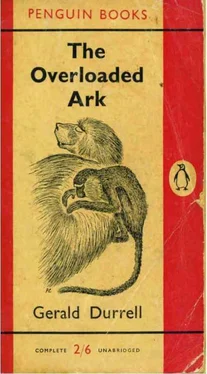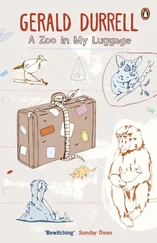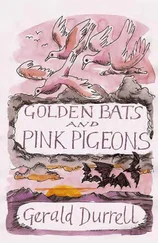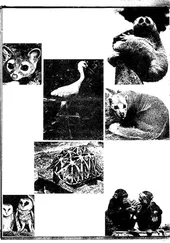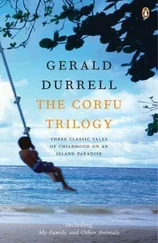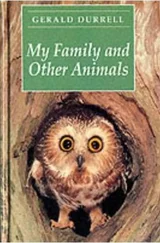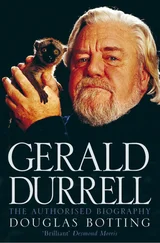We came at last to the place where we had our meeting with the “water-beef”, and though we beat the low growth thoroughly, we did not flush another. So we gave it up as a bad job and walked along the sandy banks towards the cliff where Elias said there were some caves. As we rounded the bleached carcass of a huge tree that had fallen across the bank I saw something glowing on the sand ahead of us.
“Elias, na whatee dat?” I asked, pointing.
“Na fire, sah,” he replied.
“A fire, out here?”
“Yes, sah, I tink some hunter man sleep here.”
As we walked nearer I saw that the glow was caused by the embers of a small fire. Next to the fire was a tiny, frail lean-to made out of saplings and creepers.
“Ahey!” called Elias, “someone ’e dere dere?”
There was a stirring in the depths of the hut and a black face, sleep-crumpled, peered out at us.
“Na who?” asked the stranger, and I could see he was reaching for his muzzle-loader which lay beside him. Hastily we turned our torches on to ourselves so that he could see who we were.
“Eh . . . aehh!” he gasped. “Na white man dis?” “Yes,” said Elias, “na white man dis.”
“What thing white man do for bush for nighttime?” asked the stranger, and I could see a suspicion dawning on his face that perhaps we were some sort of terrible ju-ju in disguise.
“We hunt for beef,” said Elias.
I kicked the dying fire into a small flame, sat down beside it and produced cigarettes. The stranger accepted one, but he still kept a hand on his gun.
“Elias,” I said, “bring more stick for dis fire, den we get more light, den dis man fit see I be a white man proper and not ju-ju .” Elias and Andraia laughed, and the man essayed a feeble smile and removed his hand from his gun.
We built up the fire and sat round it smoking, while Elias explained to the man who we were, and what we were doing, and from whence we came. The man, it transpired, was a wandering hunter. These men live in the forest, shooting what they can, and drying the meat. When they have as much as they can manage they trek into the nearest township and sell the meat at the market, buy fresh powder with the proceeds and set off to the bush again. This man had had very good luck, for he had shot four full-grown drills, and he showed us the dismembered bodies, dried by wood smoke. The largest male must have been a magnificent brute in life, and his dried arm, strangely like a mummy’s, was knotted with great muscles. His hands and his skull with the flesh dried close to the bone looked decidedly human. We, in our turn, explained what we were doing, and showed the hunter the water-snakes, which he was not enthusiastic over. When we rose to go I dashed him four cigarettes and he, in turn, presented me with a drill leg, saying that it was “very fine chop for white man and black”. I ate this leg in a stew, and the hunter was proved correct: it was very fine chop indeed, with a delicate and succulent flavour of beef with the faintest tang of wood smoke about it.
At last we came to the caves: they were in the face of a cliff heavily overgrown with ferns and moss, intermingled with the long creepers that hung down from the trees that grew on the top of the cliff. The usual tumbled mass of boulders littered the base, intergrown with shrubs and bushes. The largest cave was the size of a small room, and from it ran a number of narrow, low tunnels. These, however, were too small to allow us to crawl up them, so we had to content ourselves with lying on our stomachs and shining the torch up in the hopes of seeing something.
Presently we each took a section of the cliff and started a search on our own. I came to another series of these small tunnels, and as I walked along flashing my torch about, something leapt out of the undergrowth ahead and shot into one of them. I hurried to the spot, but I had not much hope of being able to corner whatever it was now that it had gained the sanctuary of its tunnel. Crouching down I shone the torch inside, and discovered that it was a false tunnel, that is to say it ran about eight feet back into the cliff face and then ceased abruptly. The floor of the tunnel was covered with various sized boulders, and the walls were gnarled and full of dark corners and crevices. I could not see the animal, but I presumed that it was hiding somewhere in there as there was, as far as I could see, no exit. Andraia and Elias were some distance away, and I did not like to shout to them to come and help as the more silently one worked the better one’s chances of surprising an animal. So I lowered myself to the ground, hung the collecting bag round my neck, put the torch in my mouth, and proceeded to crawl up the tunnel on my stomach. This method is supposed to be the time- honoured one for stalking game, but I found it quite the most painful means of progression known to man. Erosion had given the boulders, which so liberally littered the floor of the tunnel, a razor like cutting edge to their corners, and most of them had apparently been carefully designed to fit snugly into the more delicate parts of the human anatomy, and thus cause the maximum amount of pain.
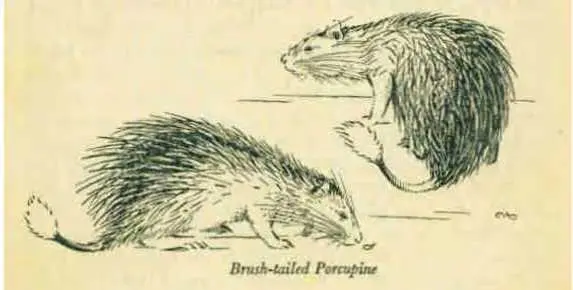
I crawled on grimly until I reached the small circular “room” at the end of the tunnel leading off into the depths of the earth. I struggled towards it, and as I reached its mouth a curious sound issued from it, a harsh, rustling rattle, a pause, two thumps, and then silence. I started to crawl closer when the rattling recommenced, a pause, the two thumps were repeated, and then silence. I hastily ran over the list of Cameroon fauna in my mind, but the noise did not seem to belong to anything that I knew of, so I continued my advance with increased caution. Reaching the tunnel I shone my torch inside and found to my surprise that it was also a cul-de-sac, only a much shorter one than the one I was in. As I was flashing my torch round in an effort to see what had produced the noise, there was another burst of rattling, something jumped forward, the torch was knocked out of my hand, and a sharp stinging pain assailed my fingers. I grabbed the torch and backed away hurriedly, and then sat down to examine my hand. On the back of it were a number of spots of blood, and a few deep scratches which now commenced to sting. It looked as though I had plunged my hand into a blackberry bush. I thought about this for a few minutes and then suddenly I realized what it was I had to deal with, one of the commonest animals in the Cameroons, and the only one that could make that noise: a Brush-tailed Porcupine. I was annoyed that I had not thought of it before.
I crawled back, and, with greater care, shone my torch in: there, sure enough, was the porcupine, standing half-turned to me, his spines bristling, and his curious tail rattling like mad. He would give a prolonged rattle on his tail, and then follow it up by stamping his hind feet petulantly, exactly as a rabbit will do when it is scared. He was about the size of a cat, though it was a little difficult to judge accurately, as his erect spines made him look larger. As all his spines pointed backwards he naturally had to stand with his bottom half turned to me, and he peered over his shoulder with his moist black eyes prominent with a mixture of anger and fear. He was mostly black in colour, except for the spines that covered his lower back, which was handsomely patched with black and white. His long tail, which he kept in a U-shape half over his back, was bare of both fur and spines. On its very tip was a curious cluster of spines which had no points: they looked like a head of wheat, pure white, thick and long. It was this appendage on his tail which produced the rattling noise, for now and again he would stiffen his tail and rattle these hollow, harmless spines together with a crisp crackling sound. He was all keyed up and alert for trouble.
Читать дальше
